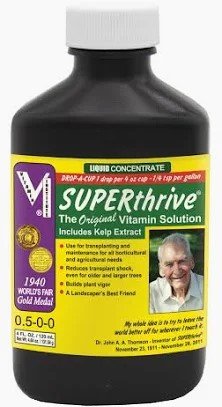Plant Health: A Tonic for “Stressed Plants”
We’re finally getting into fall, but the consistant cooler temperatures haven’t quite made it. If you have plants looking a little sun-baked or stressed, here is a great treatment to give them a bit of emergency “Tender Loving Care”. This is the “Tonic” that we use often this time of year...so here you go ;-)
Recipe:
Chelated iron
Epsom salt
SUPERthrive®
4-5 gallons of water
Each of the 3 products will give application rate instructions for “per gallon of water”. You’ll just multiply by by the # of gallons you’re making. I use a 5 gal. bucket, mixing well and allowing epsom salts to dissolve.
**You can also add some liquid seaweed as directed on label, but I only do so in a spring or summer treatment when plant growth is at its peak. It provides roughly 60 trace minerals plus amino acids and enzymes. It enhances root development and stimulates microbial activity.
Despite the name, Epsom salt is not a sodium salt like table salt, but rather a source of the minerals magnesium and sulfur. Gardeners have used Epsom salt for decades, and it has many uses in the garden. Magnesium plays a crucial role in photosynthesis – the process by which the plant converts light energy into chemical (food) energy.
Chelated iron comes in a liquid form as an easy-to-use plant supplement. Iron is used in some of the most vital functions of plants, such as: chlorophyll and enzyme production; nitrogen fixation; and metabolism and development. The symptoms of iron deficiencies in plants can be spotted with yellow leaves, usually between the dark green veins, which gives the leaf a spidery look - like the photo above.
SUPERthrive® is a combination of vitamins and plant hormones. It is not a stand-alone fertilizer but can be added to fertilizers. It is well known to reduce transplant shock.
Important: Water your plants thoroughly the day before application or apply after a good rain. Then apply the tonic as a drench, wetting the root zone of the plant. You will use ½ to 1 gallon for shrubs, less for perennials, vegetables, and bedding plants. It will take several days to see results. How often to apply depends on how stressed the plant is, time of year, and the general health of the plant in the first place. Container plants may benefit from using this tonic, but if you choose to do this, dilute it by half with water.


